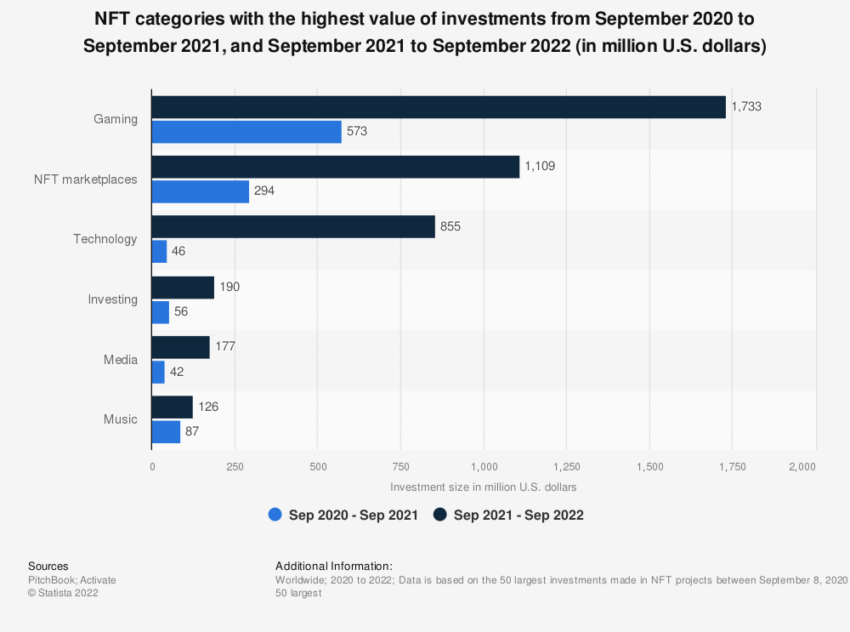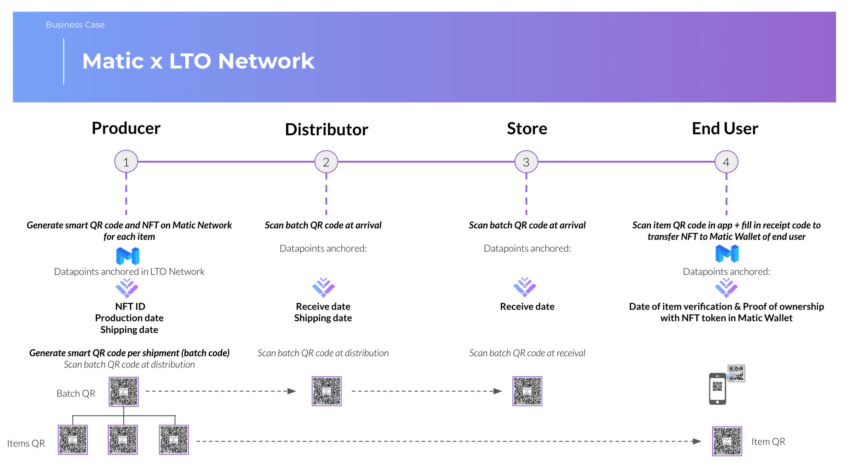NFT
NFTs, or non-fungible tokens, have evolved from a niche market limited to cryptocurrency enthusiasts to a disruptive force that is expected to redefine the global economy.
The NFT market will cross the $200 billion mark in the near future, changing the perception of value and ownership in both the digital and physical worlds.
The irrepressible power of digital resources
In 2022, the NFT market was worth a staggering $20.44 billion. This accounts for more than 72% of the global digital asset market revenue.
Forecasts predict an impressive compound annual growth rate of 34.2% from 2023 to 2030. So this indicates that the appreciation of digital assets has been phenomenal.
This trend is largely fueled by the uniqueness of NFTs that allow artists to retain ownership of their creations while benefiting from their work. The newfound financial independence is drawing creatives worldwide to the digital asset segment, fueling growth.
The concept of digital real estate is also gaining ground. Both physical and virtual properties are tokenized and traded on NFT platforms. As a result, real estate is a major contributor to the digital asset segment.
In addition, NFTs have emerged as a powerful tool to combat fraudulent transactions. They provide greater security and transparency previously unattainable in the digital landscape.
Each NFT is unique, indivisible and can be traced back to its original creator. Consequently, the authenticity of the digital asset is established and buyers are provided with an unprecedented level of security.
Revolutionary ownership of physical and digital collectibles
The physical assets segment, which includes tangible items such as homes, paintings and vehicles, is also expected to experience significant growth in the near future.
When converted into NFTs, these physical assets provide a surefire way to verify owner identity and protect against fraudulent transactions. This innovative application of NFTs extends their reach and promises to revolutionize traditional models of ownership and value.
“Decentralized finance systems hold promise in dismantling some of the limitations within TradFi and, in turn, delivering material improvements in terms of market efficiency and opportunity for asset holders. DeFi minimizes or eliminates the intermediation systems found in TradFi to effectively decentralize the back-end of financial markets,” Binance Research noted.
NFTs have also had a major impact on the collectibles industry. With over 53% of global NFT revenue by 2022, crypto collectibles minted on NFT marketplaces have become a sensation among various demographics.
The possibilities, whether it’s sports memorabilia, one-of-a-kind gaming items, or exclusive works of art, seem endless.
Read more: The art of storytelling NFT Marketing success

NFT categories with the highest investment. Source: Statistics
This trend is driven by the increased capacity of NFTs to foster a direct connection between creators and fans. It has enabled them to trade, engage and build a community around their shared interests.
The level of personal involvement and the ease of use of these digital assets are the main factors contributing to the explosive growth of the collectible segment.
The increasing influence of NFTs in the sports sector and beyond
NFTs have also found significant adoption in the sports sector. They are creating new avenues for athletes to increase their brand visibility and increase fan engagement.
It is estimated that up to five million sports fans own or are gifted an NFT, generating more than $2 billion in transactions. This significant increase from last year indicates the huge potential of NFTs to drive fan engagement and monetization in the sports industry.
Even Nike has recognized this trend and recently teamed up with Electronic Arts to bring NFTs into future EA Sports games. Its goal is to “provide unique new opportunities for members and players for self-expression and creativity through sport and style.”
“Nike’s new partnership with EA Sports will create new immersive experiences and unlock brand new levels of customization within the EA Sports ecosystem,” the press release reads.

Unique NFT users worldwide. Source: Statistics
Yet the potential of NFTs extends beyond art and sports. Traditional industries such as music, fashion and gaming are increasingly turning to NFTs to deliver unique experiences and exclusive digital content to their fan base.
NFTs have also found their way into the commercial sector. They innovate supply chain management and logistics and drive new growth opportunities.
Yuri Musienko, Business Development Manager at Merehead, believes NFTs are the gatekeepers at the heart of supply chains, confirming the authenticity of products and certifying their quality and provenance.
“For example, your customers need to check the storage conditions and source if you sell food. NFTs make it significantly easier thanks to special sensors that track temperature, humidity, etc. via GPS, then record the data in the blockchain and link it to the product’s NFT,” confirms Musienko.

NFTs in Supply Chain Management. Source: LTO Network
In addition, the COVID-19 pandemic has served as an unexpected catalyst for the NFT market. During the pandemic, the increase in funding for Art+Tech startups showed the potential of NFTs to transform the art industry.
“The COVID-19 pandemic has completely changed the picture for us – we saw a rapid increase in interest in virtual exhibitions. That situation forced us to turn around and we started helping galleries create virtual exhibitions on the internet,” says Vitomir Jevremovic, CEO of All.Art.
Similarly, Fuelarts reported that Art + Tech startups have raised approximately $380 million since the start of 2020, indicating accelerated market growth during the pandemic.
“Total funding for 249 Art+Tech startups was $3.48 billion by 2022, representing 70.8% of the total funding these startups have received since launch and 49.3% of cumulative investment in the Art +Tech industry since 2000.” noted Fuelarts.
A promising future for NFTs
With the world on the brink of a digital revolution, the expected growth of the NFT market to $200 billion represents a transformative shift.
However, an important challenge remains: educating the general population about the concept, value and authenticity of NFTs.
A coordinated effort by NFT platforms, makers and established brands can help overcome this hurdle and usher in the era of NFTs in the mainstream economy. The future of NFTs looks bright and promises to be a game-changer in the global economic landscape.

